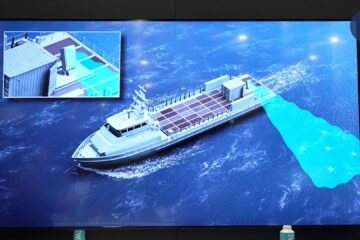Two U.S. Air Force B-1B Lancers flew from Andersen Air Force Base, Guam, and conducted training in Alaska and Japan on May 21. The long range, long endurance training, which the U.S. Air Force (USAF) defined as a “24 hours sprint” is quite unusual given that it involved multiple training areas (or “theaters”) and multiple training events. In addition, it even had a maritime component to it.
On their way back from Alaska, it appears that at least one of the B-1Bs ventured into the Sea of Okhotsk, Russia’s backyard in the Pacific. It is located between the Russia’s Kamchatka Peninsula on the east, the Kuril Islands on the southeast, Japan’s island of Hokkaido to the south, the island of Sakhalin along the west, and a stretch of eastern Siberian coast along the west and north
For the record, The Russian Navy Pacific Fleet’s Vilyuchinsk base is located in Kamchatka. The Pacific Fleet SSBNs are based there (and so will the new Borei-class SSBNs) and Russia is building special armored shelters to protect its submarines at this location.
According to the USAF press release: In Alaska, the B-1s were joined by F-22s and F-16s out of the 3rd Wing at Joint Base Elmendorf-Richardson, to conduct a large force employment exercise in the Joint Pacific Alaska Range Complex. The crews then flew southwest to Japan where they completed familiarization training in support of U.S. European Command objectives. The bombers then continued south in the vicinity of Misawa, Japan integrating with the USS Ronald Reagan and a P-8 Poseidon to conduct Long Range Anti-Ship Missile training before returning to Guam.
“These missions demonstrate our ability to hold any target at risk, anytime, and anywhere. The training value of these sorties is irreplaceable…our team conducted large force exercise training around Alaska with U.S. Air Force fighters, we conducted multiple standoff weapons training events, as well as integrated with U.S. naval assets along the way. From a readiness perspective, it is hard to think of a more valuable training sortie.”“These missions make the DoD more ready, more lethal, and flat out stronger. Our aviators are getting the chance to coordinate and practice time-sensitive target drills in the Pacific.”
Lt. Col. Ryan Stallsworth, 9th EBS commander

Anti-surface warfare (ASuW) mission are fairly new to the B-1B. The AGM-158C LRASM achieved early operational capability with the U.S Air Force B-1B in December 2018, ahead of schedule. A single USAF B-1B Lancer can carry and deploy up to 24 LRASM.
As Tyler Rogoway from The War Zone puts it, the B-1Bs pose a major threat to America’s adversaries in the region, on land and now at sea.
About AGM-158C LRASM anti-ship missile

LRASM is designed to detect and destroy specific targets within groups of ships by employing advanced technologies that reduce dependence on intelligence, surveillance and reconnaissance platforms, network links and GPS navigation in electronic warfare environments. LRASM will play a significant role in ensuring military access to operate in open ocean/blue waters, owing to its enhanced ability to discriminate and conduct tactical engagements from extended ranges.
BAE Systems’ long-range sensor and targeting technology enables LRASM to detect and engage protected ships in all weather conditions, day or night, without relying on external intelligence and navigation data.
Armed with a 1,000 Lbs (454 kg) penetrating blast fragmentation warhead, LRASM is low observable and likely has a range comparable with JASSM ER (around 500 nautical miles).
LRASM is designed to meet the needs of U.S. Navy and U.S. Air Force Warfighters in contested environments. The air-launched variant provides an early operational capability for the U.S. Navy’s offensive anti-surface warfare Increment I requirement.
LRASM Achieved EOC with the U.S. Navy’s F/A-18E/F Super Hornet in December 2019 and with the U.S Air Force B-1B in December 2018. It may soon find its way aboard the B-52 bomber of the U.S. Air Force and there are ongoing integration studies to integrated it aboard the U.S. Navy P-8A Poseidon maritime patrol aircraft.






